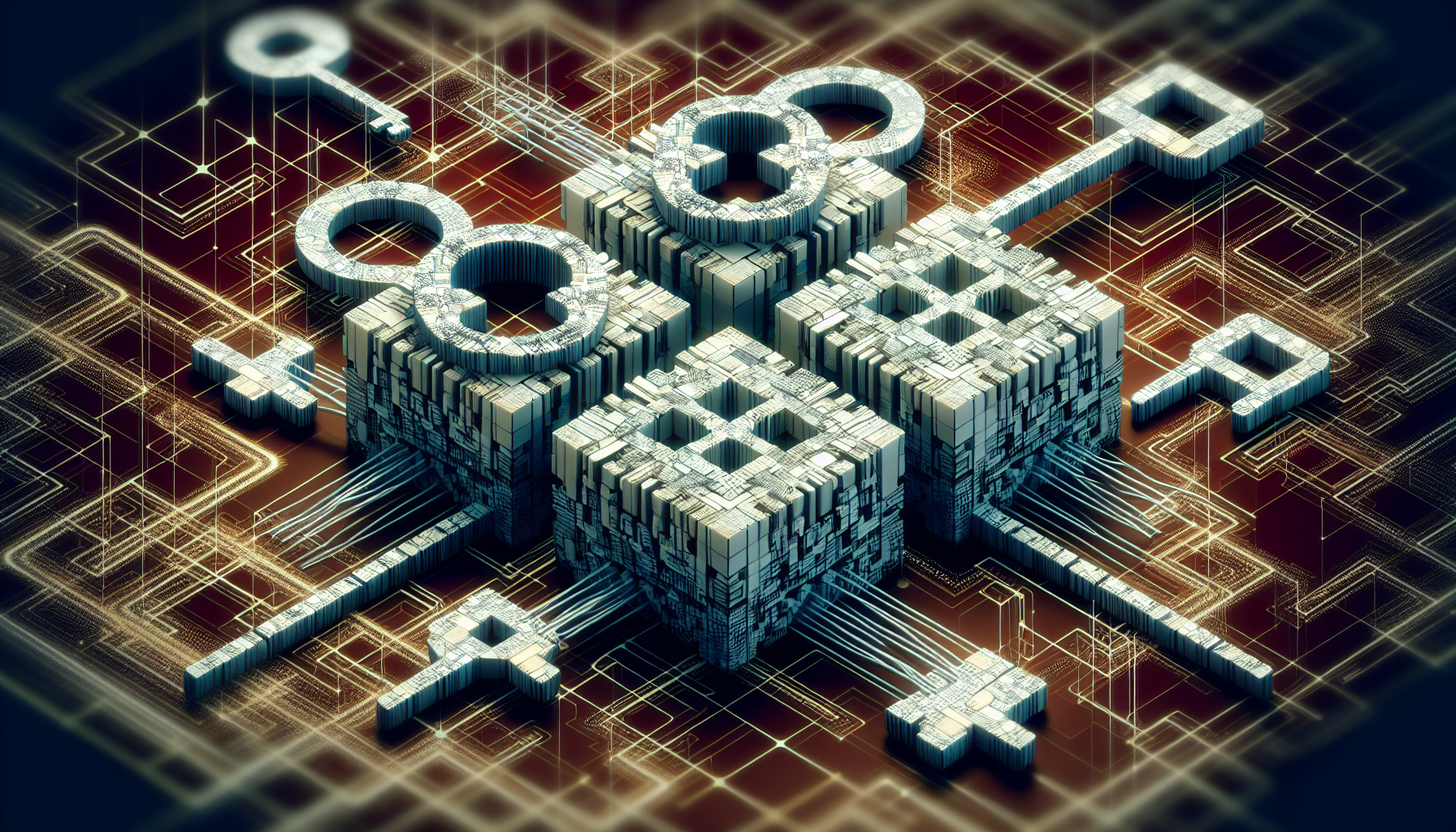Optimizing blockchain involves improving transaction speed, scalability, and security. This guide covers key strategies to optimize blockchain performance and keep systems secure and efficient.
Key Takeaways
Optimizing blockchain performance and security is crucial for maintaining scalability, cost-efficiency, and robust security measures, especially as blockchain projects grow in complexity and demand.
Techniques to enhance transaction speed, such as implementing Parallel Proof of Work, Layer 2 solutions, and choosing the appropriate consensus mechanism, significantly improve the efficiency of blockchain networks and strengthen the blockchain infrastructure.
Addressing scalability through solutions like Layer 2 approaches and sharding, along with implementing robust security measures and efficient data management strategies, are essential for the effective and secure operation of blockchain technologies.
1 Understanding the Importance of Blockchain Optimization

Blockchain technology, a form of distributed ledger technology, is a fixed digital ledger that uses cryptography to record transactions and track assets among a distributed, peer-to-peer computer network. It offers unparalleled security and transparency. This technology eliminates the risk of duplicate records and data falsification, making it an invaluable tool for tracking and trading almost anything. However, despite its numerous benefits, blockchain developers face significant challenges, including security, scalability, and decentralization. Understanding blockchain architecture is essential to address these challenges effectively.
Given the rapid growth of decentralized technologies, optimizing blockchain systems becomes increasingly critical. Optimization ensures that blockchain networks remain scalable, cost-efficient, and secure, providing a streamlined and efficient user experience. This is particularly crucial as blockchain projects scale and the demand for faster transaction processing and robust security measures increases.
Furthermore, the implementation of enterprise blockchain solutions brings additional benefits, such as enhanced operational efficiency and increased transparency. Whether dealing with private blockchains, which offer faster and more efficient operations due to their centralized nature, or public blockchains, optimization is key to overcoming the inherent challenges and leveraging the full potential of blockchain technologies.
Enhancing Transaction Speed
Blockchain latency represents a primary concern in blockchain technology. Slow transaction times can hinder the adoption of blockchain applications, making it essential to explore methods for enhancing speed. Techniques like Parallel Proof of Work (PoW) allow miners to solve puzzles collectively, significantly improving transaction speed. Additionally, Layer 2 solutions, such as the Lightning Network, can offload transactions from the main blockchain, thereby increasing transaction speed and reducing fees.
Selecting the right consensus mechanism also plays a significant role in enhancing transaction speed. While Proof-of-Work (PoW) mechanisms are known for being slow and energy-intensive, alternatives like Proof-of-Stake (PoS) and Delegated Proof-of-Stake (DPoS) offer faster and more energy-efficient solutions. These mechanisms select validators based on the amount and duration of their stake, enhancing speed and reducing energy consumption.
Gas Optimization Techniques
To enhance blockchain efficiency in applications, gas optimization becomes a crucial factor. One effective technique is minimizing on-chain data by using events instead of storing data directly, which can significantly reduce gas consumption in Solidity contracts. Additionally, using mappings over arrays in Solidity can save up to 93% of gas costs, as mappings provide direct access to data.
Other gas optimization techniques include packing smaller than 256-bit variables together, which can save up to 13% of gas costs, and declaring variables as ‘constant’ or ‘immutable’ to reduce gas costs associated with storage operations. By implementing these best practices, developers can streamline operations and enhance the operational efficiency of their blockchain solutions.
Choosing the Right Consensus Mechanism
To optimize transaction speed and energy consumption in blockchain networks, choosing the correct blockchain consensus mechanism is imperative. Proof-of-Stake (PoS) mechanisms, for example, enhance transaction speed by selecting validators based on the amount and duration of their stake. This method is not only faster but also more energy-efficient compared to Proof-of-Work (PoW) mechanisms.
Delegated Proof-of-Stake (DPoS) further accelerates transaction speeds by electing a smaller number of trusted nodes to validate transactions, making the process more efficient. Additionally, innovative mechanisms like Bitcoin-NG decouple leader selection from transaction serialization, further improving transaction speeds. By choosing the right consensus mechanism, blockchain developers can provide efficient and streamlined operations for their applications.
Improving Blockchain Scalability

Another formidable challenge in blockchain technology is scalability, encapsulated in the ‘blockchain trilemma,’ illustrating the trade-off between decentralization, security, and scalability. One strategy to improve blockchain throughput and scalability is increasing the block size, allowing more transactions to be included in each block. However, this approach also raises storage needs and processing power requirements for each node.
To address these challenges, blockchain projects are exploring various solutions. Layer 2 solutions, such as the Lightning Network and Plasma, handle transactions off-chain and then consolidate them on the main chain, reducing the data load on the primary blockchain. Another promising approach is sharding, which partitions the blockchain into smaller segments, allowing nodes to process transactions in parallel and enhancing throughput.
Layer 2 Solutions
Improving blockchain scalability heavily relies on blockchain off-chain Layer 2 solutions. These solutions handle transactions off-chain, significantly reducing the data load on the main blockchain while maintaining its security features. The Lightning Network, for instance, facilitates faster micropayments by creating a second layer network on top of the main blockchain, enhancing transaction speed and reducing fees.
Plasma, another Layer 2 solution, uses smart contracts on the main chain to anchor faster processing child chains, offering flexibility but adding design complexity. Additionally, solutions like Zero-Knowledge Rollups and Optimistic Rollups operate on top of base blockchains to enhance transaction speed and scalability. These innovations in Layer 2 technologies are crucial for the future of scalable blockchain networks.
Sharding
By utilizing blockchain partitioning to divide the blockchain into smaller segments or shards, sharding offers a potent technique for enhancing blockchain scalability, as it allows nodes to process transactions concurrently. This method enhances the throughput of blockchain networks by enabling horizontal scaling, where the addition of more nodes increases capacity.
Each shard operates independently, which helps distribute the data storage and processing load across multiple nodes. However, inter-shard communication and ensuring security guarantees are significant concerns when implementing sharding. Despite these challenges, sharding remains a promising solution for addressing the scalability needs of growing blockchain ecosystems.
Security Enhancements for Blockchain Networks

Given the sensitive data and digital assets handled by blockchain networks, addressing blockchain vulnerabilities and ensuring security is of utmost importance. Implementing robust security measures, such as:
encryption
multi-factor authentication
secure coding practices
regular security audits
is crucial for mitigating risks and avoiding malicious attacks. Continuous monitoring and threat detection are also essential for identifying and mitigating suspicious activities.
To further enhance security, it’s important to:
Store keys in hardware-based solutions
Regularly rotate private keys to reduce the risk of compromise
Educate users on blockchain security best practices to reduce the risk of phishing and social engineering attacks
By adopting these strategies, blockchain networks can maintain a high level of security and trust.
Implementing Strong Authentication
For the protection of blockchain networks and safeguarding private keys from unauthorized access, the implementation of robust authentication methods, including blockchain authentication, is imperative. Multi-party Computation (MPC) techniques, for example, can be used to distribute key generation and management, enhancing security. Multi-signature authentication, which requires multiple private keys to authorize a transaction, adds an extra layer of security against single points of failure.
Hardware Security Modules (HSMs) offer a secure environment for key storage and cryptographic operations, mitigating risks of key exposure. By implementing these strong authentication methods, blockchain networks can ensure that transactions are secure and that private keys are protected from potential attacks.
Smart Contract Audits
To detect and mitigate potential security breaches, conducting frequent blockchain auditing and smart contract audits is crucial. Conducting regular security assessments of smart contract code helps identify and rectify vulnerabilities before deployment. This proactive approach ensures that smart contracts are secure and reliable, reducing the risk of malicious attacks.
By incorporating regular audits into the development process, blockchain projects can maintain high security standards and build trust among users. These audits, combined with other security measures, form a comprehensive strategy for protecting blockchain networks and their users.
Optimizing Blockchain Data Management

With an increasing number of transactions being processed by blockchain technology, the need for efficient blockchain storage solutions escalates. Strategies like reducing data replication, redacting data, and compressing data can enhance security, decentralization, and scalability. These optimizations aim to decrease the duplication of blockchain data shared among participants and ensure that data is stored efficiently.
Replication-based optimizations reduce the duplication of data, while redaction-based optimizations allow for the modification or deletion of data already committed to the blockchain ledger. Content-based optimizations involve compressing data either before or after it is committed to the blockchain ledger, further enhancing efficiency. By implementing these strategies, blockchain networks can manage data more effectively and reduce storage costs.
Efficient Data Storage Solutions
To maintain the operational efficiency of blockchain networks, the implementation of efficient blockchain data storage solutions becomes crucial. Decentralized storage options like Arweave and Filecoin offer robust solutions by leveraging peer-to-peer networks for data storage. Arweave focuses on data permanence, while Filecoin uses its native cryptocurrency FIL to provide a peer-to-peer network for data storage.
Other solutions, such as Sia and Storj, offer decentralized storage by encrypting and dispersing files across a global peer-to-peer network, ensuring data confidentiality and eliminating single points of failure. These storage solutions enhance data security and provide efficient and cost-effective options for blockchain projects.
Data Privacy and Confidentiality
For maintaining user trust, it’s necessary to ensure blockchain privacy, data privacy, and confidentiality in blockchain applications. Blockchain applications must balance transparency with privacy requirements to ensure confidential data is protected. Techniques like redactable blockchains allow for specific data modifications, helping maintain privacy while complying with regulatory requirements.
Encrypting data before storing it on decentralized networks, such as Sia or Storj, further enhances privacy and confidentiality. However, the immutability of blockchain can conflict with data protection regulations that require personal data to be kept up-to-date or deleted at an individual’s discretion.
By addressing these challenges, blockchain eliminates projects can ensure that data privacy and confidentiality are maintained.
Leveraging Hardware Accelerators
The use of blockchain hardware, like FPGA technology, presents a significant avenue for enhancing blockchain performance. FPGA technology can accelerate blockchain algorithms by distributing transaction loads among several components, providing flexibility and efficient use of power. The Varium C1100 Blockchain Accelerator Card, for instance, is a customizable accelerator card designed for maximum performance and minimal power consumption.
By incorporating hardware accelerators into blockchain solutions, developers can achieve higher performance and efficiency, making their applications more robust and scalable. These accelerators play a crucial role in optimizing blockchain systems for large-scale deployment.
Best Practices for Blockchain Development
Creating robust and scalable solutions necessitates strict adherence to blockchain best practices in blockchain development. Here are some key steps to follow:
Clearly define the objectives of your blockchain project, which guides development efforts and ensures success.
Draft detailed business requirements to create a tangible product roadmap, setting clear deadlines and resource allocations.
Select an appropriate blockchain platform, considering factors like scalability, consensus mechanism, security features, and community support.
Following these steps will help you create a successful private blockchain solution by implementing blockchain.
Planning for scalability from the beginning is vital, as it allows your blockchain architecture to efficiently handle a growing number of transactions and users. Adhering to industry standards and best practices, including standardized data formats and coding conventions, ensures consistency and interoperability. Comprehensive testing, such as unit, integration, performance, and security testing, is crucial before deployment to identify and resolve potential issues. Maintaining thorough documentation and staying updated on new platforms, protocols, and tools are also essential for continuous innovation and adaptation.
Identifying Business Needs
In the process of blockchain development, a foundational step is the identification of blockchain business needs. It involves understanding what problem you’re solving or what process you’re improving with blockchain technology to align development with business objectives. Conducting market research helps define the scope and requirements of your blockchain project, ensuring that the solution provides real business value and competitive advantage.
By aligning the blockchain project with specific business needs, developers can ensure that the solution addresses actual pain points and delivers measurable benefits. This approach not only increases the likelihood of project success but also enhances the overall impact and adoption of the blockchain application.
Developing Custom Blockchain Nodes
Blockchain node development demands meticulous consideration of various factors such as:
Network permissions
Programming languages
Deployment strategies
Operating systems
Whether the network will be permissioned or permissionless determines the level of access control and security measures required. The choice of programming languages and deployment strategies should align with the project’s technical requirements and goals.
Implementing the consensus algorithm and creating a user interface are key steps in developing custom blockchain nodes. These components ensure that the blockchain network operates smoothly and that users can interact with the system effectively. By considering these factors, developers can create tailored blockchain nodes that meet the specific needs of their projects.
Legal and Regulatory Considerations
For blockchain projects, adhering to legal and regulatory standards, including blockchain compliance, is a key aspect. Ensuring that your blockchain system complies with existing laws concerning:
Anti-money laundering
Consumer protection
Sanctions
Tax and reporting requirements
is essential for avoiding legal issues and maintaining trust. The decentralized nature of blockchain presents unique challenges for compliance, as many governments are still working to understand and regulate this technology.
It is important for organizations to collaborate closely with their legal and compliance teams. This collaboration helps to ensure that all activities conform to regulatory standards. Considering jurisdiction-specific laws and regulations, along with the advice of local counsels, helps navigate the complex legal landscape of blockchain. Additionally, the governance model and contractual relationships among blockchain network participants should be clearly established in legal documentation to address issues of legal status and liability.
The Future of Blockchain Optimization

Blockchain innovation is driving emerging trends and exciting possibilities in the future landscape of blockchain optimization. The global blockchain market is projected to grow exponentially, driven by innovations in areas like Decentralized Finance (DeFi), which uses blockchain to create a peer-to-peer financial system that bypasses traditional banking. Web3 is anticipated to decentralize the internet, allowing users to control their own data and receive tokens for participation.
Non-Fungible Tokens (NFTs) are set to tokenize offline goods and real assets, offering proof of ownership and new investment opportunities. Some key trends in the blockchain industry include:
Play-to-earn games using NFTs have seen a significant rise, contributing to a large portion of blockchain activity.
The Metaverse, an immersive 3D world, will leverage blockchain for gaming, NFTs, digital payments, and identity authentication.
Cross-chain functionality is emerging to facilitate seamless transitions between different blockchain ecosystems.
These trends highlight the ongoing evolution and potential of the blockchain ecosystem, as it continues to develop and expand the capabilities of blockchain technology.
Summary
In conclusion, this blockchain summary highlights the importance of optimizing blockchain performance and security for the successful implementation and adoption of blockchain technology. By enhancing transaction speed, improving scalability, bolstering security measures, and managing data more efficiently, developers can create robust and efficient blockchain solutions. As the blockchain landscape continues to evolve, staying updated on best practices and emerging trends will ensure that blockchain projects remain at the forefront of innovation and security.
Frequently Asked Questions
What are the key strategies to enhance blockchain transaction speed?
To enhance blockchain transaction speed, key strategies involve implementing Parallel Proof of Work, Layer 2 solutions, and selecting an appropriate consensus mechanism like Proof-of-Stake or Delegated Proof-of-Stake. These strategies can significantly improve the efficiency of blockchain transactions.
How can blockchain scalability be improved?
To improve blockchain scalability, consider increasing block size, implementing Layer 2 solutions like the Lightning Network and Plasma, and using sharding to partition the blockchain into smaller segments. These methods can help alleviate scalability issues and enhance the overall performance of the blockchain.
What measures can enhance blockchain security?
To enhance blockchain security, it’s important to implement robust measures such as encryption, multi-factor authentication, secure coding practices, regular security audits, and continuous monitoring and threat detection. These measures help to safeguard the blockchain system from potential threats.
Why is data management important in blockchain, and how can it be optimized?
Managing data is crucial for maintaining security and efficiency in blockchain networks. It can be optimized by reducing data replication, redacting data, and compressing data.
What are some emerging trends in blockchain optimization?
Some emerging trends in blockchain optimization include Decentralized Finance (DeFi), Web3, Non-Fungible Tokens (NFTs), play-to-earn games, the Metaverse, and cross-chain functionality, which are currently shaping the future of blockchain technology.
Posted in Blockchain, Smart Contract, Technologies





